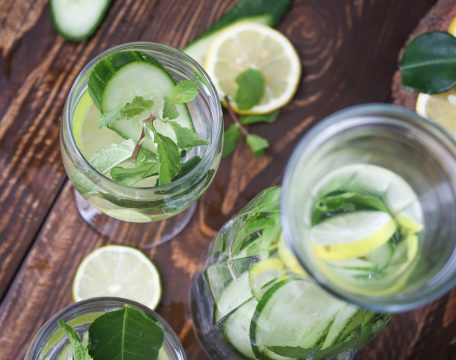- You have no items in your shopping cart
- Continue Shopping

Tulsi, an Ayurvedic herb widely used in therapeutic herbal tea and true tea blends, maybe called Tulasi, holy basil, “The Incomparable One,” “Elixir of Life,” or “Queen of the Herbs.” Native to India and cultivated throughout Southeast Asia, it’s considered a primary herb that has many benefits.
What are the ingredients of Tulsi Tea?
The tulsi plant (Ocimum sanctum or Ocimum tenuiflorum) is a member of the mint family closely related to culinary basil (Ocimum basilicum). It has been harvested for use in Ayurvedic treatments for many years and has a strong aroma and a unique flavour. It’s often combined with black, green, or white tea leaves or in a herbal blend with other health-promoting ingredients like turmeric & ginger
Tulsi is native to India and Southeast Asia. Tulsi is considered an adaptogenic herb. Adaptogens are plants that help to adapt the body to stress and boost energy. Tulsi contains several beneficial compounds including:
- Eugenol: a terpene with pain-relieving properties, also found in clove oil
- Ursolic and rosmarinic acid: compounds with antioxidant, anti-inflammatory, and anti-ageing properties
- Apigenin: a flavonoid that helps the body removes waste at the cellular level
- Lutein: an antioxidant carotenoid important for eye health
- Ocimumosides A and B: compounds that reduce stress and balance the neurotransmitters serotonin and dopamine
Health Benefits of Tulsi Tea:

Tulsi has been used for centuries to cure symptoms of various diseases and ailments, but its power has resurfaced in modern times. Some scientific studies have shown its efficacy as an anti-inflammatory, anxiety treatment, and antioxidant etc.
Combats Respiratory Ailments
Tulsi may relieve symptoms of asthma, bronchitis, colds, congestion, coughs, flu, sinusitis, sore throat, and similar ailments. To clear your sinuses, inhale the steam from a fresh cup of tea before you drink it. Scientists discovered that dietary supplementation with tulsi and clove protected the animals’ lungs against colonization with Klebsiella pneumonia, a common hospital-acquired bacteria known to cause pneumonia and urinary tract infections.
Lowers Blood Pressure and Reduces Stress
Regular consumption of tulsi may lower blood pressure and cholesterol by regulating cortisol levels, reducing the risk of stroke, heart attack, and other related diseases. It can also help relieve headaches and may lessen anxiety and depression for some. Regular consumption may lead to better sleep and correcting the sleep cycle. Making tulsi tea a part of your diet can help you manage your circadian rhythm, regularize your sleep cycle, boost your memory and cognition, and also avert ageing-induced neurodegenerative disorders like Alzheimer’s.
Treats Gastrointestinal Disorders
Tulsi can be used to treat indigestion, intestinal parasites, ulcers, vomiting, gastric disorders, and stomach or menstrual cramps. It may also reduce pain from kidney stones and could help prevent them.
Relieves Arthritis
Tulsi tea may help reduce inflammation and relieve the joint pain associated with arthritis.
Regulates Blood Sugar
Drinking tulsi tea can help maintain stable blood sugar levels. It may also improve metabolism and promote the efficient processing of carbohydrates and fats. Thus, it has a protective and curative role in the treatment of Diabetes.
Antiseptic
Tulsi may kill damaging bacteria in the mouth, resulting in cleaner teeth and fresher breath. It can also alleviate acne, slow the effects of ageing, and relieve the itch or sting of bug bites.
Mercury Poisoning
A 2002 study on mice suggests that treatment with tulsi may provide protection against mercury-induced toxicity, which known to damage the central nervous system, endocrine system, kidneys, and other organs.
Uses
Alternative medicine practitioners use tulsi as a powerful adaptogenic herb (a herb that reduces stress and increases energy). It may also reduce the frequency and severity of asthma attacks, work as an anti-inflammatory, and promote detoxification. It can modulate the immune system and protect the liver from environmental toxins. In the United States, tulsi is most commonly found packaged for use as a herbal. In Asia, cooks often add fresh holy basil leaves to stir-fries or soups. Tulsi tea can stimulate the production of gastric juices so that the food you take in gets digested completely and quickly.
It also has anti-ulcerogenic properties, i.e., it inhibits undesirable pepsin secretion and lipid peroxidation and increases the production of gastric mucin and mucous cells in defence.
Incorporating tulsi tea in your diet can result in lowering of your cholesterol levels because of its hypolipidemic action.
Since it enables quick digestion and assimilation of the ingested carbohydrates and proteins, the lipids and fats get broken down slowly – thereby reducing hunger pangs and leaving you with a full tummy. Also, drinking tulsi tea post-meals prevents GERD and associated risks of heartburn.
Indirectly, the delayed lipid assimilation without its peroxidation cause weight loss and lower your serum cholesterol and triglyceride levels.
The holy basil is one of those herbs whose leaves and other parts’ extracts are applied to heal wounds.
Topical application of a paste made of tulsi leaves or a thick, concentrated tea preparation of these leaves will accelerate the wound contraction, drying up, and peeling off. Pain necessarily accompanies all wounds. Managing pain in the case of deep injuries without interfering with wound healing is one of the major challenges. In such cases, drinking tulsi tea frequently works like magic.
Pinene, limonene, linalool, carvacrol, eugenol, and related derivatives are responsible for giving tulsi tea the antinociceptive or analgesic property. It is as potent as a synthetic painkiller drug.
Ayurveda and ancient medicine mention tulsi to have antibacterial, antiviral, and antifungal properties. These properties, along with the anti-inflammatory effects, make it an effective antipyretic.
Administering tulsi tea to people with fever will bring down the body temperature, stimulate the elicited immune response, and reduce the severity of the pathogenic infection.
Inflammation of the eye is caused due to bacterial (e.g., Streptococcus, Pseudomonas), fungal (e.g., Fusarium, Aspergillus), and viral (Herpes simplex virus) infections, or ocular injuries due to chemicals, sharp splinters, plant saps, or conditions like glaucoma and conjunctivitis.
Due to its anti-inflammatory, analgesic, and healing properties, tulsi tea supports the action of ophthalmic medication administered in the form of drops or flush eye suspensions and assists in rapid recovery.
How to make a Drink of Tulsi Tea?
One easy way to consume tulsi is to brew a herbal tea or a herbal infusion. To make tulsi tea, boil 1 cup of filtered water and pour it over 1 teaspoon of fresh tulsi leaves, 1/2 teaspoon of dried tulsi leaves, or 1/3 teaspoon of tulsi powder. Cover the water in a pot or mug and let it steep for 20 minutes (or longer, if you want to maximize the health benefits). Then strain the leaves, add honey if desired, and enjoy.

Caffeine Content in Tulsi Tea
Tulsi tea is caffeine-free and can be safely consumed up to six times a day. However, tea producers often combine tulsi with black, green, or white tea leaves, so check the package carefully if you want to avoid caffeine.
Buying and Storing
You can buy loose dry tulsi at natural food stores, from speciality tea retailers, or online. It’s also available as the main ingredient in a selection of packaged herbal teas or as a powdered drink mix. Store dried tulsi in an airtight container in a cool, dark, dry location such as your pantry or a cupboard and use it within a year of purchase for the greatest health benefits. It’s also an easy plant to grow in pots at home; most Indian households have multiple tulsi plants.
Types of Tulsi Tea
There are three main types of tulsi plants:
- Rama Tulsi (also known as green leaf tulsi): A green tulsi with light purple flowers and an aromatic, clove-like scent (thanks to its chemical composition of eugenol, which is the main aroma in cloves) and mellower flavour.
- Krishna Tulsi (also known as Shyama Tulsi or purple leaf tulsi): A purple plant with a clove-like aroma and peppery flavour.
- Vana Tulsi (or wild leaf tulsi): A bright, light green tulsi plant that grows wild and is indigenous to many areas of Asia; it has a more lemon aroma and flavour.
Side Effects
Tulsi may decrease fertility in men and women, so anyone hoping to conceive should refrain from consuming large quantities of tulsi. It’s also recommended that women avoid tulsi while breastfeeding. Some people experience nausea or diarrhoea when they first add tulsi tea to their diet, so it’s best to start with small quantities and increase your consumption over time. Tulsi may also slow blood clotting, so doctors generally tell patients to avoid it for at least two weeks before and after any surgery.
Tulsi may interfere with pharmaceutical drugs, so it’s best to confer with your doctor if you’re being treated with medications for any chronic or acute condition before you start using it.

Dr Pallavi Kwatra is Medical Doctor, Author, Publisher, Entrepreneur and Spiritual Saadhak. She has 11 published books and her books, writings & digital gymnastics can be accessed at her website drpallavikwatra.com.




